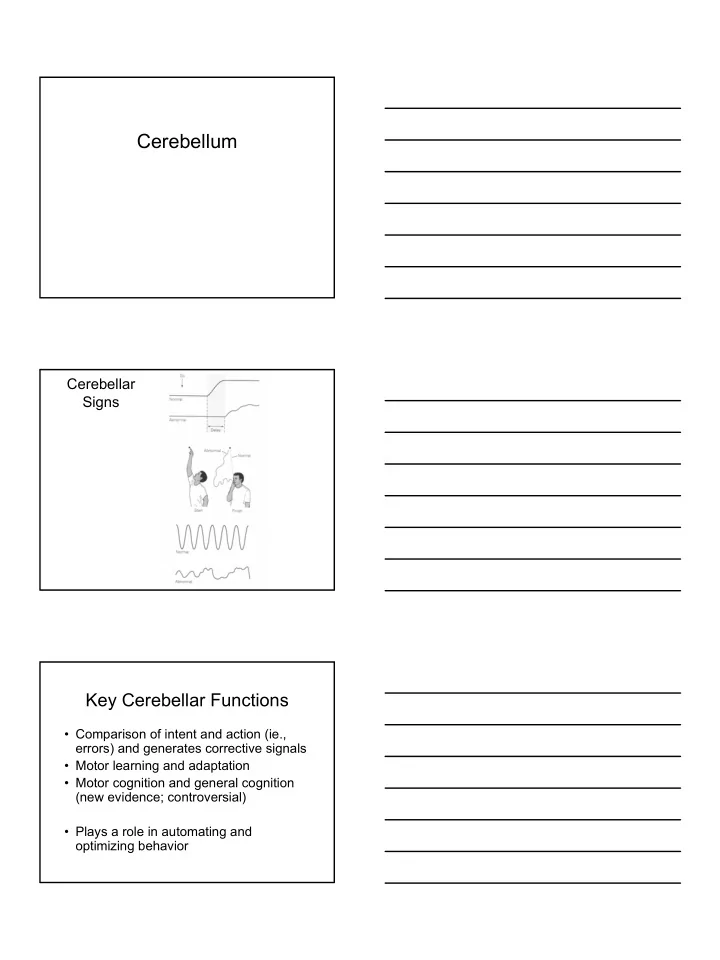

Cerebellum Cerebellar Signs Key Cerebellar Functions • Comparison of intent and action (ie., errors) and generates corrective signals • Motor learning and adaptation • Motor cognition and general cognition (new evidence; controversial) • Plays a role in automating and optimizing behavior 1
Lecture Plan: • Structural and functional overview • Principal pathways into and out of the cerebellum • Experimental approaches to reveal: – Anticipatory control – Motor learning – Mental processes underlying movement control Motor Hierarchy 1° Som sensory Intent Actual Exerts influence at all levels Cerebellar Functional Anatomy 2
Folia Cerebellar Cortex Deep Cerebellar Nuclei: Dentate Interposed Fastigial 3
Input-output Organization Deep Cerebellar Nuclei: Fastigial Cerebellar cortex Interposed + Dendate Cortex + - Nuclei + Output Vestibular nuclei Extrinsic inputs: mossy fiber climbing fiber Cerebellar Divisions Spinocerebellum: Vermis Spinocerebellum Spinocerebellum Intermediate hem. (Vermis Vermis + + Intermed Intermed. Hem) . Hem) ( Cerebrocerebellum: Lateral hem. Control of limbs and trunk Cerebrocerebellum (Lateral hemisphere) Planning of movement+ Vermis IV th vent Vestibulo-cerebellum Intermediate hem. (Floculo-nodular lobe) Lateral hem. Control of eye & head movements Balance Floculo-nodular lobe Molecular layer Purkinje layer Granular layer White matter Nissl-stained section through cerebellar cortex 4
Cerebellar Cortex Inputs Climbing fibers Mossy fibers Output Purkinje neurons Interneurons Granule neurons Stellate neurons Basket neurons Golgi neurons Apical dendrites Cell Purkinje body neuron Cerebellar Cortex Inputs Climbing fibers Mossy fibers Output Purkinje neurons Interneurons Granule neurons + Stellate neurons - Basket neurons - Golgi neurons - 5
Cerebellar Cortex: activation by mossy fibers Inputs Climbing fibers Mossy fibers Output Purkinje neurons Interneurons Granule neurons Stellate neurons Basket neurons Golgi neurons + - to Deep Cerebellar Nuclei Cerebellar Cortex: activation by climbing fibers Inputs Climbing fibers Mossy fibers Output Purkinje neurons Interneurons Granule neurons Stellate neurons Basket neurons Golgi neurons + - to Deep Cerebellar Nuclei Inferior olivary nucleus: source of all climbing fibers to cerebellum, via inferior peduncle Mossy fibers from all other sources 6
Cerebellar Cortex: Inhibitory interneurons Inputs Climbing fibers Mossy fibers Output Purkinje neurons Interneurons Granule neurons Stellate neurons Basket neurons Golgi neurons Functional divisions Spinocerebellum Vermis Intermediate hemisphere Spinocerebellum Vermis Cerebrocerebellum Intermediate hem Lateral hemisphere Cerebrocerebellum Lateral hemisphere Inter Dentate posed Fastigial Vestibulo- cerebellum Vestibulo- cerebellum Floculo-nodular lobe To To frontal To To motor areas lateral medial vestibular sysetms sysetms nuclei Motor Motor Eye mvt & planning execution balance 7
Medial & lateral systems Interposed nuclei Fastigial Vestibulocerebellum via vestibular nuclei Intermediate and Lateral Hemispheres Planning and Thalamus and limb control Cortical motor areas Brain stem nuclei Cerebellar cortex & Deep nuclei Ipsilateral Intermediate and Lateral Vermis & Vestibulocerebellum Hemispheres Thalamus and Cortical motor areas Cerebellar cortex & Deep nuclei Brain stem nuclei Axial control Ipsilateral Bilateral 8
Functions of the Cerebellum • Feed - forward or predictive motor control (nuts & bolts of skillful movements) • Motor learning/adaptation • Non - m o tor functions: – Active tactile exploration – Higher brain functions (cerebellar cognitive- affective syndrome) Anticipatory control • Anticipating the motor consequences of an event – See stop light and brake – Predict baseball location during batting – Anticipating duck location in an video game • Cerebellum’s role: – Fairly low level routines – Correlations & associations • Implemented via lateral and medial pathways Feed-Forward or Predictive Control Normal: • Perturbation extends arm, stretching biceps • Muscle action flexes arm and tends to restore arm position • Anticipatory contraction of triceps (extensor) prevents flexion overshoot – Occurs during triceps shortening; not stretch reflex – BRAKE • Result: arm position stabilized at start position 9
Feed-Forward or Predictive Control Block cerebellar function (cool): • Perturbation extends arm, stretching biceps • Biceps contraction prolonged • Muscle action flexes arm but well beyond initial arm position-- OVERSHOOT • Delayed triceps contraction – Reverts to simple stretch reflex – LOSS of brake (antic. control) • Result: cycle of flexion- extension (similar to cerebellar tremor) Feed-Forward or Predictive Control Delayed triceps (antagonist) produces oscillations Motor Learning 10
Non-motor Function Passive stimulation Discriminate roughness Manipulate only Manipulate + discriminate Cerebellar Motor Functions • Implemented via lateral and medial pathways, especially the corticospinal tract • Incorporated into motor programs via frontal motor areas (SMA, premotor cortex…) • Becomes part of motor strategy via prefrontal cortex 1° motor Executing cortex movements Premotor Planning cortex movements Dorsolateral Movement prefrontal strategies cortex Working memory MD All work together VA/VL during a motor task: Lateral -anticipatory control during cerebellum motor learning -using sensory information Intermediate to guide movement cerebellum 11
Cerebellar Cognitive Affective Disorder • Lesions of the posterior lobe and vermis • Impairment of executive functions – Planning, verbal fluency, abstract reasoning • Difficulties with spatial cognition – Visuo-spatial organization, visual memory • Personality changes – Blunting of affect, inappropriate behaviors • Language disorders – Agrammatism Anterior Emotions/affect cingulate cortex Dorsolateral prefrontal Cognition cortex MD Lateral cerebellum Conclusions • Cerebellar lesions produce – Incoordination & errors not weakness – Lose ability to anticipate errors – Lose ability to correct • Motor learning • Not just motor 12
Recommend
More recommend